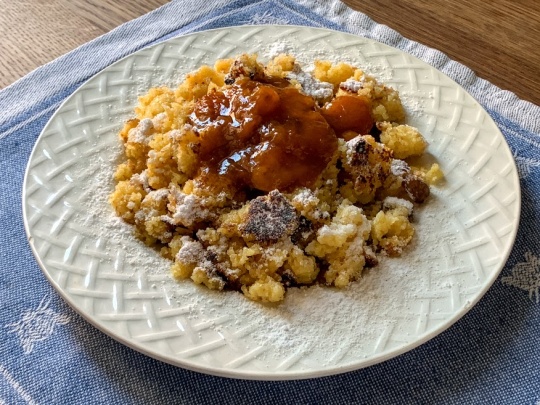
This shredded pancake sprinkled with powdered sugar and raisins is another adored dessert across the former Austria-Hungary (the American novelist F. Scott Fitzgerald called the dish simply "formidable"). Some say it's named after “the Kaiser,” Habsburg emperor Franz Joseph, but more likely is that it originated among Alpine herdsmen ("Kaser"). In Hungary, people make it with semolina instead of regular wheat flour and bathe the plate in runny fruit preserves.
Ingredients
Yield: 3-4 servings; Total time: 20 minutes cooking time plus 30 minutes resting time
200 grams (1 large cup) semolina flour
60 grams (½ cup) all-purpose flour
350 ml (1 ½ cups) whole milk
4 large eggs, separated into yolks and whites
4 tablespoons sugar (50 grams or ¼ cup)
1 teaspoon vanilla sugar (or 1 teaspoon vanilla extract or 1 vanilla bean scraped)
4 tablespoons butter (for the pan)
1 tablespoon freshly grated lemon zest and lemon juice (using 1 medium lemon)
60 grams (⅓ cup) raisins, soaked in rum or warm water for 10 minutes and drained
Pinch of salt
Powdered (confectioners’) sugar to finish
Runny apricot, raspberry, or other type of fruit preserves
Directions
Step 1: In a small pot or large bowl, add semolina, flour, milk, egg yolks, sugar, vanilla sugar (or extract), pinch of salt, and lemon zest. Using an electric mixer or a whisk, blend it into a batter, then stir in the raisins. Let it rest for at least 30 minutes for semolina to absorb the liquid and the batter to thicken.
Step 2: In a large bowl, combine egg whites and lemon juice. Using a stand or a hand mixer, beat the egg whites until stiff. With a spatula, carefully fold the egg whites into the batter without breaking up the beaten whites too much but dispersing them evenly.
Step 3: Melt the butter in a large pan on medium until it starts to bubble. Then pour in the batter and, without stirring, let its bottom settle and crisp-up slightly, about 4-5 minutes. Then, using a wooden spoon, start to gradually break the solidifying dough into bite-sized chunks and stir so that their sides turn golden brown, about 10 more minutes. Take care not to let it overcook and dry out: dough pieces should remain slightly moist when you remove from the heat.
Step 4: Serve the kaiserschmarrn on individual plates, generously sprinkle with powdered sugar and runny fruit preserves.
Words of advice
Some people in Hungary shred the dough into small crumbs, others prefer more sizable pieces; there’s no one way of doing it. I like a mix of both.
I created these recipes with the help of nearly a dozen historical Hungarian cookbooks, adjusting ingredients, cooking times, and methods to reflect my own preferences and tastes of the current day. Do you have any feedback? Please let me know!